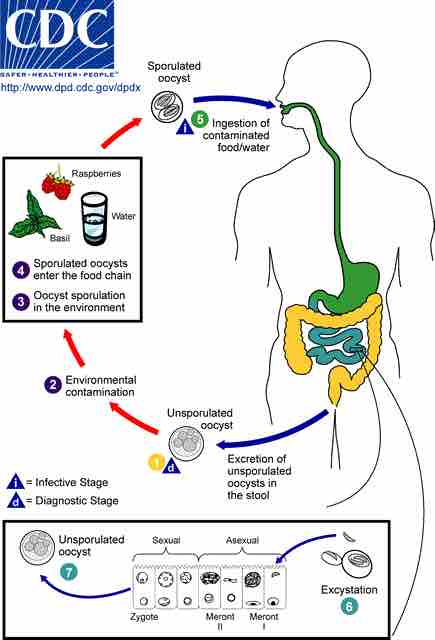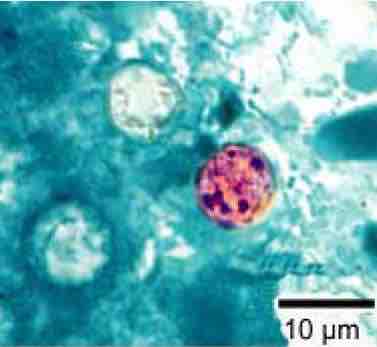Cyclospora diarrheal infection, commonly referred to as travelers diarrhea or cyclosporiasis, is caused by a specific species of Cyclospora. The protozoan that are categorized as cyclospora are defined by the spherical shape of the sporocysts. Specifically, Cyclospora cayetanensis is the species associated with the disease in both humans and primates. Cyclospora can be transmitted by consuming contaminated food or water. In 2012, cyclospora caused about 500 infections in 2012 in the US from a salad mix imported from Mexico and used in restaurants in Texas and Arkansas.
Life Cycle of Cyclospora
The life cycle of Cyclospora begins when the host is exposed and ingests the pathogen either in its oocyst or spore form. The oocyst is comprised of sporocytes which contain sporozoites. Upon release of the sporozoites, the epithelial cells of the intestine are penetrated. Within the intestinal cells, the sporozoites undergo multiple fission and develop into meronts which contain merozoites. The merozoites then undergo division and produce micro- and macro-gametes representing male and female gametes, respectively.
These gametes then reproduce and result in the formation of oocysts. It is the oocysts which pass through the intestinal tract and are released into the feces. The oocysts demonstrate the ability to undergo sporulation in a crop and water host as well beginning with the oocyst stage. It is during the oocyst stage that cyclospora exhibit a high resistance to disinfectants.

Life cycle of cyclospora
Cyclosporiasis (Cyclospora cayetanesis) When freshly passed in stools, the oocyst is not infective (1) (thus, direct fecal-oral transmission cannot occur; this differentiates Cyclospora from another important coccidian parasite, Cryptosporidium). In the environment (2), sporulation occurs after days or weeks at temperatures between 22°C to 32°C, resulting in division of the sporont into two sporocysts, each containing two elongate sporozoites (3). Fresh produce and water can serve as vehicles for transmission (4) and the sporulated oocysts are ingested (in contaminated food or water) (5). The oocysts excyst in the gastrointestinal tract, freeing the sporozoites which invade the epithelial cells of the small intestine (6). Inside the cells they undergo asexual multiplication and sexual development to mature into oocysts, which will be shed in stools (7). The potential mechanisms of contamination of food and water are still under investigation.
Symptoms of Cyclospora
The symptoms associated with this disease are categorized as gastroenteritis based issues. The symptoms range from watery, loose stool, weight loss, cramping, fatigue, vomiting, fever and nausea. The symptoms can be extremely severe if presented in an immunocompromised patient, such as a patient living with AIDS. The transmission of cyclospora to humans most often occurs by ingesting contaminated foods. In regions of the world where there is lack of health regulations, the chances of cyclospora exposure is increased. Often times, the contaminants include fresh fruits and vegetables which have been exposed to contaminated soil. Individuals exposed to these pathogens in these of regions are at high risk for developing cyclosporiasis, hence, the origin of the commonly known name, traveler's diarrhea.

Cyclospora cayetanensis oocysts
A photomicrograph of oocysts from Cyclospora cayetanensis derived from a fresh stool sample.